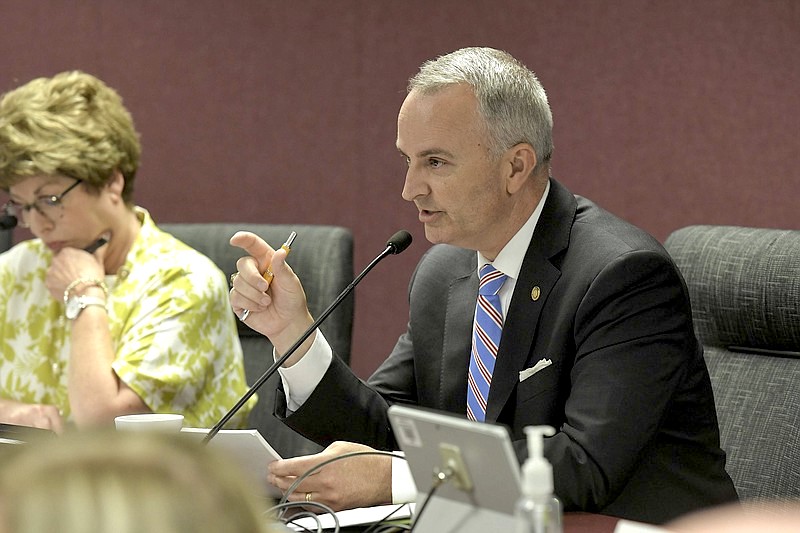Nearly 40% of Missouri’s $10B education dept. budget reflects ‘mission creep’ and ‘bureaucratic bloat,’ says lawmaker
Of the $10 billion allotted to K-12 education in Missouri’s current budget, $4 billion may never make it to the classroom.
If that staggering amount of money alarms taxpayers and school parents,…

Of the $10 billion allotted to K-12 education in Missouri’s current budget, $4 billion may never make it to the classroom.
If that staggering amount of money alarms taxpayers and school parents, they’re not alone. It’s a big concern for Rep. Doug Richey, R-District 39, who chairs the Joint Committee on Education in the Missouri Assembly.
“Of DESE’s $10+ billion dollars that are in the proposed budget currently, over 40% of that budget would be tied to mission creep or bureaucratic bloat, and is far afield from actual classroom instruction,” Richey told The Lion.
“We’re looking at a little over $6 billion that you could tie closely to classroom instruction or the supports that are required for teachers getting what they need to be able to actually teach students.”
Where is the $4 billion going if not to the classroom?
Richey offers two illustrative examples: social security determination and adult education.
Richey explains that DESE has a contract with the federal government to make social security disability insurance determinations for Missouri residents who apply. Although federal funding is available for it, it still requires administrative oversight from DESE.
“There’s nothing in doing disability determination that ties it to children in public education,” he says. “[Administrators] have to police the activities of SSI disability determination, which, at a minimum, distracts from their primary purpose.”
A second area of mission creep is adult education, Richey says.
“[DESE] is also spending money and tasked with the responsibility of adult education. Now, why are they doing that as opposed to the Department for Higher Education and Workforce Development?” he asks.
“On and on and on, we see examples of mission creep that are problematic, and it’s all tucked into this $10+ billion budget for DESE.”
‘What do we have to show for it?’
Richey isn’t the only one scrutinizing DESE.
The Show-Me Institute, a Missouri-based think tank, released a 48-page report on Monday examining the department’s funding in detail, raising concerns about DESE’s size and manageability.
“Significant efforts have been made at both the state and federal levels to equalize resources and opportunities for a high-quality education across Missouri, which has led to a growing administrative body and a laundry list of programs,” writes Susan Pendergrass, Show-Me’s director of education policy and the author of the report, which categorizes and describes every program funded within DESE.
Like Richey, Pendergrass is concerned about how many dollars actually make it to the classroom.
“Let’s just say the average spending per student is $12,000 and you have a classroom of 20 kids,” Pendergrass told The Center Square. “That’s $240,000 and the teacher gets paid $60,000 and maybe a total of $90,000 with benefits. So where does the other $150,000 go?”
Wherever it’s going, data on student outcomes suggest the spending is ineffective, including the enormous spending efforts on disadvantaged students over the last 20 years.
“Since the passage of No Child Left Behind, and for decades before that, Missouri has devoted billions to the education of low-income students, students with disabilities, and other disadvantaged groups,” Pendergrass writes, before asking pointedly, “What do we have to show for it?”
Data from 2003–2019 shows proficiency gaps between low-income and non-low-income students increased by five percentage point in math and reading, the report reveals. The same percentage increase was seen in students with disabilities compared to those without.
“In Missouri, like most places, spending on public education only goes up,” Pendergrass writes. “The machine that administers the state’s effort costs almost $200 million per year to run. Five billion in revenue collected by the state from Missouri taxpayers is distributed back to school districts to try to even the playing field between wealthy and poor communities.
“And yet, we have very little to show for it in terms of improvement in overall academic achievement or improvement in reducing gaps between student groups.”
School choice vs. school as government social services hub
The inefficiency of public education spending leads Richey to a fundamental principle of school choice: fund students instead of systems.
“All of that funnels back into why I believe it’s extremely important for us to refocus ourselves through a kind of recalibration to fund students rather than systems,” Richey says. “Because when you tie dollars to a particular student, it incentivizes classroom instruction over that kind of mission creep or bureaucratic bloat.”
Missouri currently has a limited school choice scholarship program available primarily to low-income students in certain geographic areas. But numerous bills in the state Legislature would expand school choice, including a universal school choice bill in the Senate.
Meanwhile, some states are moving in the opposite direction, with plans to drastically expand the system by making government social services available to not only students, but families as well.
California Gov. Gavin Newsom recently announced a $4 billion plan to make one out of every three California public schools a “community school.”
“These schools take a holistic approach to education by offering students and families a variety of services that meet the needs of the community, such as free meals twice a day, physical health screenings and mental health counseling, free before, after, and summer school programs, transitional kindergarten, and more,” First Partner Jennifer Siebel Newsom said in a statement shared by the governor’s office on the effort.
It’s not just California. A less formalized effort to expand K-12 education to include social services is happening all over the country, including in Missouri.
Richey recently met with a group of school administrators who asked him about universal free lunches and breakfasts for Missouri public school students.
“Let me ask you a question that touches on priorities,” Richey recalls telling the group. “You are wanting me to support the appropriation of additional money for free lunches for people who can afford to pay for their own lunches.”
“Are you saying that [free meals are] more important than you guys having money to actually pay teachers more?” he asked the school leaders.
“It would actually be good to have both,” the answer came.
“Well, no, it doesn’t work that way,” Richey replied. “I can’t spend the same dollar two times over.”
Free meals are just one example of a larger, decades-long trend, according to Richey:
“It’s because we’re turning our public schools into a hub for social services. We started that a long time ago, and now we are absolutely connected to this concept, that a public school district is the hub for the Department of Mental Health, Social Services Children’s Division, Health and Senior Services, Medicaid programs.”
Richey says he is not opposed to supporting strategic funding increases in areas that positively affect student outcomes, but the most effective funding strategy is to give parents control over those education dollars through school choice.
Pendergrass agrees.
“In 2023, the state could write checks for $10,000 to every K-12 student, with an additional $5,000 for every student living below the poverty line, $5,000 for every student with a disability, $5,000 for every pre-K student, and $2,500 for every student learning English as a second language for roughly the same amount as the 2023 DESE state and federal budget (and this doesn’t even account for local contribution),” she writes.
“What if those funds were instead given directly to families?”



